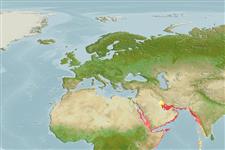Actinopterygii (ray-finned fishes) >
Perciformes (Perch-likes) >
Mullidae (Goatfishes)
Etymology: Parupeneus: Latin, parum, parvum = small + Peneus, the name of a river. More on author: Randall.
Environment / Climate / Range
Ecology
Marine; reef-associated; depth range 1 - 55 m (Ref. 54393). Tropical, preferred ?
Western Indian Ocean: Persian Gulf and the Gulf of Oman to western Pakistan.
Size / Weight / Age
Maturity: Lm ? range ? - ? cm
Max length : 23.0 cm TL male/unsexed; (Ref. 11441)
Dorsal
spines
(total): 8;
Dorsal
soft rays
(total): 9;
Anal
spines: 1;
Anal
soft rays: 7;
Vertebrae: 24. Diagnosis: Pectoral rays 15-17 (usually 16). Gill rakers 6-8 + 22-25 (total 29-33). Body moderately elongate, the depth 3.5-4.05 in SL (to 4.35 in juveniles); head length (HL) 2.75-3.0 in SL; snout length 1.75-2.3 in head length; upper-jaw length 3.0-3.5 in HL; barbels relatively short, 1.4-1.65 in HL; third dorsal spine longest, 1.65-1.95 in HL; last dorsal soft ray only slightly longer than penultimate ray; pectoral-fin length 1.5-1.7 in HL; pelvic-fin length 1.5-1.8 in HL. Gray to brownish red dorsally, whitish to light red ventrally, with a small pearly white to pale blue spot on each scale of body below the lateral line (center of scales on body above lateral line whitish but not as a distinct spot); an elongate white spot anteriorly on upper side of caudal peduncle, sometimes followed by a dusky spot of about the same size; a brown band on snout from upper lip to eye, often continuing onto postorbital head and narrowly a short distance onto body (band usually not persisting in preservative) (Ref. 54393).
Occurs on open sand or silty sand bottom or on sand and rubble in the vicinity of reefs or rocky outcrops (Ref. 54393).
Life cycle and mating behavior
Maturity | Reproduction | Spawning | Eggs | Fecundity | Larvae
Randall, J.E., 2004. Revision of the goatfish genus Parupeneus (Perciformes: Mullidae), with descriptions of two new species. Indo-Pac. Fish. (36):64 p. (Ref. 54393)
IUCN Red List Status (Ref. 115185)
CITES (Ref. 94142)
Not Evaluated
Threat to humans
Harmless
Human uses
More information
Common namesSynonymsMetabolismPredatorsEcotoxicologyReproductionMaturitySpawningFecundityEggsEgg development
Age/SizeGrowthLength-weightLength-lengthLength-frequenciesMorphometricsMorphologyLarvaeLarval dynamicsRecruitmentAbundance
ReferencesAquacultureAquaculture profileStrainsGeneticsAllele frequenciesHeritabilityDiseasesProcessingMass conversion
Tools
Special reports
Download XML
Internet sources
